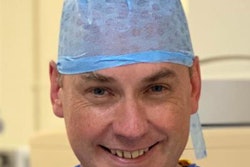
More than 75% of radiologists now use social media sites for both professional and personal purposes, but the need to avoid pitfalls and to decide whether to adopt multiple online identities remain important issues, according to research presented at this week's U.K. Radiological Congress (UKRC) in Liverpool.
The Radiology and Social Media (RANSOM) survey was conducted by Dr. Erik Ranschaert, radiologist at the Jeroen Bosch Hospital in 's-Hertogenbosch, the Netherlands, between March and May 2015. It involved 516 radiologists and trainees, the majority from Europe and North America but also with some participation from Asia, South America, and Africa.
Speaking to AuntMinnieEurope.com ahead of his UKRC presentation on 1 July, Ranschaert said the most popular sites for general use were Facebook, LinkedIn, Twitter, and YouTube. For professional purposes, LinkedIn was by far the most popular site among the European radiologists surveyed, while in the U.S., Twitter took first place. Appropriate use of social media results in better patient care, but it is important that health professionals enhanced use and avoided the pitfalls.
"Engaging with social media is now unavoidable. It is important that radiologists explore social media and social networking sites and evaluate how to integrate these tools into their unique workflow and professional needs," he stated.
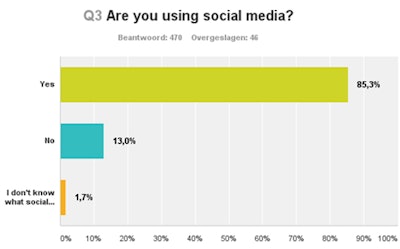 Use of social media is growing fast for both private and professional purposes. Unpublished data from the 2015 RANSOM survey. Beantwoord = answered, Overgeslagen = skipped. All images courtesy of Dr. Erik Ranschaert.
Use of social media is growing fast for both private and professional purposes. Unpublished data from the 2015 RANSOM survey. Beantwoord = answered, Overgeslagen = skipped. All images courtesy of Dr. Erik Ranschaert.Ranschaert called for in-depth social media training for specialists and said that when correctly harnessed, it can help increase the visibility of the profession, promote scientific findings and ideas, and stimulate important discussion compared with peer-reviewed journal publication alone. In particular, he pointed to the dilemma radiologists and other medical professionals face regarding virtual profiles, potentially leading them to resort to multiple identities.
"This confronts us with the idea of a virtual 'identity crisis,' " he noted. "The question is how to handle it. Do we each have two profiles as is suggested in some national guidance, for example in the U.K. and in Holland?"
This may not be practical, and as Dr. Matthew DeCamp, PhD, and colleagues stated in a 2013 article in the Journal of the American Medical Association (14 August 2013, Vol. 310:6, pp. 581-582), it is also easy to trace activity and link the personal profile with the professional. There needs to be an ethical discussion of how to deal with this media, how to limit access to profiles, and what radiologists publish on them, and this needs to be incorporated into training, according to Ranschaert.
Of 13 potential reasons for professional use, radiologists cited the top four purposes as staying in touch with professional news and development in radiology, communicating with colleagues about radiological topics, sharing or discussing interesting or difficult cases/images with colleagues, and increasing influence/promoting ideas and vision among radiologists. Other high scoring reasons included increasing visibility of the profession among patients and the wider public, providing information about exams, making expertise and knowledge available for teaching, and marketing radiological services.
The survey results showed that more than 85.3% of respondents used social media, 13% didn't use it, and 1.7% didn't know what it was. Of those who used it, 85.2% engaged with it professionally (75.6% both privately and professionally, and 9.6% only professionally). The remaining 14.8% used social media only privately.
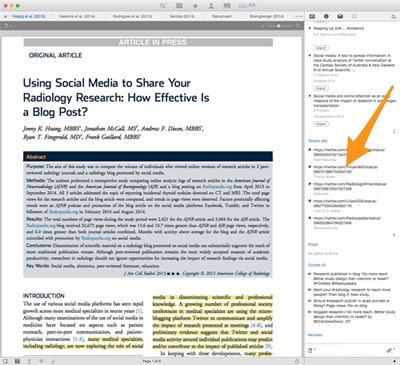
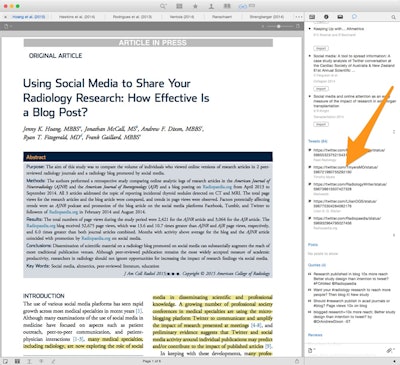
Software programs can list all comments/tweets pertaining to a paper and provide a direct link to Twitter or other networks in turn, stimulating discussion and bolstering readership.
More positively, Ranschaert believes that social media sites may support scientific journal publications, rather than compete with them. He highlighted how certain software would allow readers to obtain a list of all tweets that reference a certain paper. Clicking on any of the links would open up Twitter, both encouraging them to read the paper and allowing them to comment.
"Another recently published paper also shows how important this virtual world is becoming. In 'Using Social Media to Share Your Radiology Research: How Effective Is a Blog Post?' by Hoang et al, the authors suggest that blog-published scientific papers can increase interest tenfold or higher," noted Ranschaert, citing the article in press from the Journal of the American College of Radiology (7 May 2015) in his talk.
Dr. Jenny Hoang and colleagues acknowledge the rapid growth in medicine of social media for professional purposes, despite a degree of scepticism from many academicians accompanied by concerns about scientific rigor, privacy, and the uncertainty about the effectiveness and overall value of social media. The authors believe that their study provides additional evidence suggesting that dissemination of scientific findings and discussion via social media may increase the reach and visibility of such research compared with traditional peer-reviewed journal publication alone.
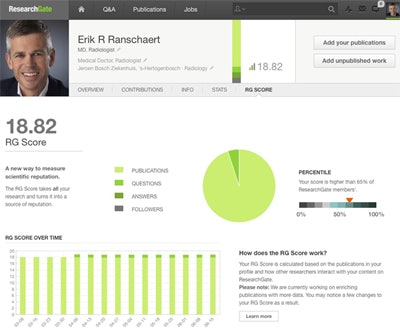
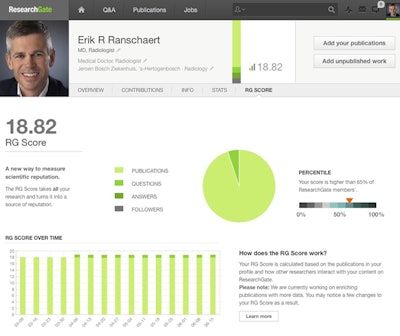
Despite social media's lack of peer review, online commentators and contributors can be analyzed and the reliability of their opinions gauged through online profile scores.
While blog posts were open to all to read and comment on, tracing the reliability of the author of a paper or a commentator might be difficult. On Twitter, authors' profiles reveal frequency of tweets sent, number of followers and other measurable data. ResearchGate, a platform dedicated to science, analyzes contributors and gives them a score. If a contributor's score is high, his or her reactions are likely to have more impact on readers. Other websites such as Symplur.com reference how influential a commentator is in the healthcare arena. Typing or accessing www.symplur.com/search/radiology, for example, will bring up a list of radiology "influencers" that is constantly updated by analyzing Twitter activity.






